八年级英语上册时态复习
八年级上册五大时态知识点
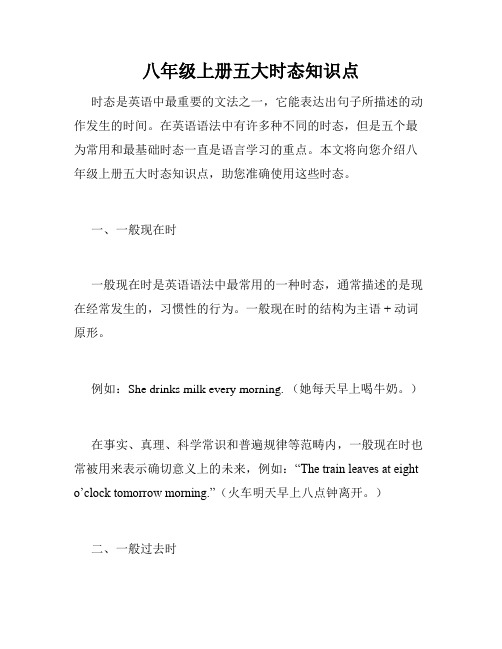
八年级上册五大时态知识点时态是英语中最重要的文法之一,它能表达出句子所描述的动作发生的时间。
在英语语法中有许多种不同的时态,但是五个最为常用和最基础时态一直是语言学习的重点。
本文将向您介绍八年级上册五大时态知识点,助您准确使用这些时态。
一、一般现在时一般现在时是英语语法中最常用的一种时态,通常描述的是现在经常发生的,习惯性的行为。
一般现在时的结构为主语 + 动词原形。
例如:She drinks milk every morning. (她每天早上喝牛奶。
)在事实、真理、科学常识和普遍规律等范畴内,一般现在时也常被用来表示确切意义上的未来,例如:“The train leaves at eight o’clock tomorrow morning.”(火车明天早上八点钟离开。
)二、一般过去时一般过去时用于过去完成的动作或状态,它可以与过去的时间连用,也可以与一段英语中的已知或者同时提供的信息联系起来。
一般过去时的结构为主语 + 动词的过去式。
例如:I went to the supermarket yesterday. (我昨天去了超市。
)在过去描述的事件或者经历中,一般过去时是最适合的时态。
比如把新闻内容翻译成英文时,用到的就是一般过去时。
三、现在进行时现在进行时用于描述当前正在发生或进行的事情,是与现在紧密相关的一种时态。
现在进行时的结构为主语 + am / is / are + 动词的 -ing 形式。
例如:I am drinking tea at the moment. (我此刻正在喝茶。
)现在进行时可以体现出动作的临时性和正在进行态的状态。
当指代当前正在进行的动作时,它是最适合的时态,特别是在描述美食、追剧等活动时使用较多。
四、过去进行时过去进行时用于描述过去某个时间段正在进行的事情,经常用于强调过去某个时刻正在进行的某一个动作。
过去进行时的结构为主语 + was / were + 动词的 -ing 形式。
八年级英语知识点

一、动词的时态1.一般现在时:表示经常性、习惯性的动作或状态2.现在进行时:表示现阶段正在进行的动作3.一般过去时:表示过去发生的动作或存在的状态4.过去进行时:表示过去其中一时刻正在进行的动作5.一般将来时:表示将来发生的动作或存在的状态6.将来进行时:表示将来其中一时刻正在进行的动作二、名词的单数和复数形式1.一般情况下,在名词后直接加s来表示复数形式。
2. 以s, x, ch, sh结尾的名词,加-es表示复数形式。
3. 以y结尾的名词,变y为i,再加-es表示复数形式。
4. 以f或fe结尾的名词,变f或fe为v,再加-es表示复数形式。
三、形容词的比较级和最高级1. 一般情况下,形容词的比较级在词尾加-er,最高级在词尾加-est。
2. 以e结尾的形容词,直接加-r表示比较级,加-st表示最高级。
3. 以辅音字母+y结尾的形容词,变y为i,再加-er表示比较级,加-est表示最高级。
4. 以重读闭音节结尾,且末尾只有一个辅音字母的形容词,双写最后一个辅音字母,再加-er表示比较级,加-est表示最高级。
四、副词的比较级和最高级1. 一般情况下,副词的比较级在词尾加-er,最高级在词尾加-est。
2. 以e结尾的副词,直接加-r表示比较级,加-st表示最高级。
3. 以辅音字母+y结尾的副词,变y为i,再加-er表示比较级,加-est表示最高级。
4. 以重读闭音节结尾,且末尾只有一个辅音字母的副词,双写最后一个辅音字母,再加-er表示比较级,加-est表示最高级。
五、情态动词情态动词是表示说话人的情态或态度的一类助动词,如can, could, may, might, must, shall, should, will, would, 以及need, ought等。
它们后面加动词原形。
六、直接引语和间接引语的转换1.直接引语是指直接引用他人的原话。
转述别人说的话时,可以采用间接引语,即将对方的原话进行转述。
八年级上册m1u2知识点
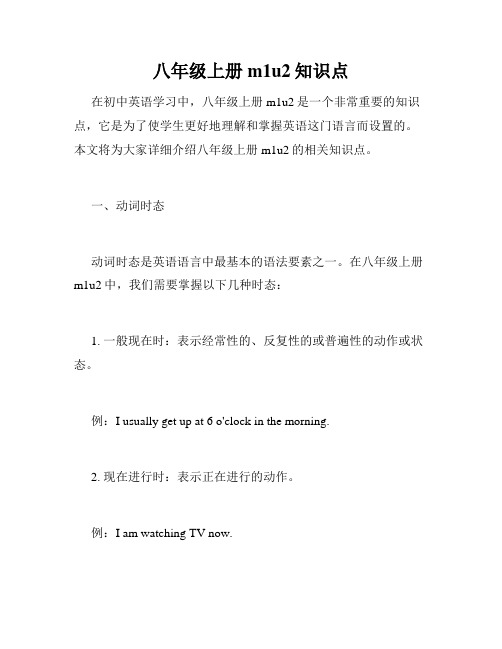
八年级上册m1u2知识点在初中英语学习中,八年级上册m1u2是一个非常重要的知识点,它是为了使学生更好地理解和掌握英语这门语言而设置的。
本文将为大家详细介绍八年级上册m1u2的相关知识点。
一、动词时态动词时态是英语语言中最基本的语法要素之一。
在八年级上册m1u2中,我们需要掌握以下几种时态:1. 一般现在时:表示经常性的、反复性的或普遍性的动作或状态。
例:I usually get up at 6 o'clock in the morning.2. 现在进行时:表示正在进行的动作。
例:I am watching TV now.3. 一般过去时:表示过去某个时间发生的动作或状态。
例:I ate breakfast at 7 o'clock this morning.4. 过去进行时:表示过去某个时刻正在进行的动作。
例:I was watching TV at 8 o'clock last night.5. 一般将来时:表示将来要发生的动作或状态。
例:I will go to Beijing next month.二、动词时态的被动语态动词时态的被动语态是英语语言中非常重要的一部分。
在八年级上册m1u2中,我们需要掌握以下几种被动语态:1. 一般现在时的被动语态:am/is/are + 过去分词。
例:The flowers are watered by me every day.2. 现在进行时的被动语态:am/is/are + being + 过去分词。
例:The book is being read by me now.3. 一般过去时的被动语态:was/were + 过去分词。
例:The cake was made by my mother yesterday.4. 过去进行时的被动语态:was/were + being + 过去分词。
例:The car was being repaired by my father when I came back home.5. 一般将来时的被动语态:will be + 过去分词。
人教版八年级英语上册知识点总结

人教版八年级英语上册知识点总结一、基本语法1.时态:英语时态分为以下几种:现在时、过去时、将来时。
每种时态又分为简单时态、进行时态、完成时态和完成进行时态等。
例如:–现在时:简单现在时: 主语 + 动词原形;进行现在时:主语 + be(am/is/are) + v-ing;完成现在时:主语 + have / has + 过去分词;完成进行现在时:主语 + have / has + been + v-ing。
–过去时:简单过去时:主语 + 动词过去式;进行过去时:主语 + was / were + v-ing;完成过去时:主语 + had + 过去分词;完成进行过去时:主语 + had + been + v-ing。
–将来时:简单将来时:主语 + will / shall + 动词原形;进行将来时:主语 + will / shall + be + v-ing;完成将来时:主语 + will / shall + have + 过去分词;完成进行将来时:主语 + will / shall + have + been + v-ing。
2.倒装句:倒装是指把谓语动词放在主语前面形成的一种语法现象。
如:Only in this way can we solve the problem. (只有这样才能解决问题。
) 倒装句句型格式为:_____+主语(名词或代词)+_____。
在不同的情况下需要用到不同的“辅助动词/助动词”来进行倒装。
3.被动语态:被动语态就是在句子中表达动作的承受者(即主语)的语态。
结构为:被(或受)动责任的动词(to be) + 过去分词。
如:The book was written by him.(这本书是由他写的。
)4.虚拟语气:虚拟语气是指在表示假设,愿望,建议等语气时所使用的一种语态形式。
其结构为:主语+should/could/might/would+(have)+动词原形。
如: If I were you, I would buy this dress(如果我是你,我会买这件衣服。
初二上册英语时态复习题

初二上册英语时态复习题一、选择题1.I ___________ to the party last night, but I had to study for the test.a)went b) am going c) will go d) have gone2.She _________ in the park every morning.a)walks b) walked c) is walking d) will walk3.By the time he arrives, we _______ for an hour.a)will wait b) are waiting c) have been waiting d) have waited4.They _________ to the beach last summer.a)go b) went c) are going d) have gone5.We _________ a movie tomorrow evening.a)watch b) watched c) are watching d) will watch6.She _________ to Paris next week.a)fly b) flew c) is flying d) will fly7.He _________ the dishes when I arrived home.a)washed b) washes c) is washing d) was washing8.The sun _________ in the east.a)rises b) rose c) is rising d) will rise9.I _________ my homework yesterday.a)finish b) finished c) am finishing d) will finish10.They _________ married next month.a)get b) got c) are getting d) will get二、用适当的时态填空1.We _______ (visit) our grandparents next weekend.2.Susan _______ (study) for her exams right now.3.The train _______ (leave) in five minutes. Hurry up!4.They _______ (watch) a movie last night.5.By this time tomorrow, I _______ (finish) writing my report.6.He _______ (play) tennis every Sunday.7.We _______ (not go) to the party last week because we were busy.8.I _______ (not see) him since last month.9.The teacher _______ (explain) the lesson at the moment.10.I _______ (not eat) anything since morning.三、改错题1.They goes to school by bus every day.2.She don’t like chocolate cake.3.He is play soccer with his friends now.4.We will going to the movies tomorrow.5.My brother doesn’t went to work yesterday.四、根据句意,用括号中所给动词的适当形式填空1.I usually _______ (get) up at 7 o’clock in the morning.2.They _______ (not play) basketball yesterday.3.She _______ (not watch) TV every day.4.He _______ (read) a book at the moment.5.We _______ (not go) to the park last weekend.6.The teacher _______ (teach) English every Monday.7.They _______ (not swim) in the pool yesterday.8.He _______ (do) his homework right now.9.My mom _______ (cook) dinner in the kitchen.10.The dog _______ (bark) loudly outside.五、根据汉语意思完成句子1.我们明天去看电影。
八年级上册知识点和时态复习

八年级上册知识点复习Module 1 How to learn English1.practise doing sth. 练习做某事2. study plan学习计划3. a number of +可数名词复数+V(复数):许多、很多the number of+可数名词复数+V(单数):……的数量4.advice建议paper纸(都是不可数名词)a piece of advice一条建议 a piece of paper 一张纸three pieces of paper 三张纸5. give sb. some advice给某人一些建议advise sb. to do sth. 建议某人去做某事write it / them down把它(它们)写下来6. What else? 还有什么其它的?7. It is adj.(形容词)+for sb. to do sth. (对某人来说)做某事怎么样It is difficult for old people to learn English well. 对于老年人来说学习英语很难。
It is adj. (形容词)+ (of sb.) to do sth. 某人做某事某人怎么样It is very kind of you to help me. 你能帮我你真好。
(以上动词不定式短语在句中作真正主语,It 是形式主语)8.It is a good idea\way to do sth. 做某事时个好主意(好方法)。
9.this term这学期last term上学期next term下学期10.help sb. (to)do sth. help sb. with sth. 帮助某人做某事11.ask for advice征求意见basic questions基本问题12.spend cost take pay 表示“花费”的区别:人(作主语)+spend on sth.人(作主语)+spend (in) doing sth. 某人花费时间做某事物(作主语)+cost (花某人多少钱)It takes sb. some time to do sth. 花某人多少时间去做某事人(作主语)+pay for(付钱、花钱)13.the meaning of……的意思14. try to do sth. 尝试做某事15.talk\speak to sb.与某人谈话16. write to sb. 写信给某人17.start a conversation开始一段谈话18.talk about sth. with sb.跟某人谈论某事19.as much\many as possible尽可能多地Let’s sp eak English as much as possible.Let’s find out what else we can do to save as many animals as possible.20. much 修饰不可数名词many 修饰可数名词21.make mistakes \make a mistake 犯错误22.listen to听…后接听的对象,listen for 注意听,倾心听23.a way to do sth\ (good )ways to do sth. 做某事的(好)方法24. several times 几次25. What’s happening? 发生什么事?What happens to sb?=What’s wrong with sb.= What’s the matter with sb.某人发生什么事?26.something new\old\interesting 新\旧\有趣的东西\事情。
英语人教版八年级上册时态

1一般现在时态:表示经常或者反复发生的动作。 every day .often, usually, always, on Sundays 肯定句:非三单 +动词原形 三单+ 动词s/es 否定句: 非三单+ don’t 动词原形 三单+ doesn’t 动词原形 问句: Do +非三单 + 动词原形? Does +三单+ 动词原形? 2、一般过去时态: 表示过去发生的动作。 Yesterday, last week, two days ago 肯定句: 主语 + 动词过去式 否定句: 主语+ didn’t 动词原形
• • • • • • • •
3、一般将来时态: 表示将要发生的动作。 tomorrow, next week, in two days 肯定句: 主语+will +动词原形 主语+ be going to + 动词原形 一般疑问句: Will + 主语 + 动词原形? Be + 主语 + going to + 动词原形? 否定句: 主语+ will not (won’t) + 动词原形 主语+ be (is am are)not going to + 动词原 形
plays • 1.Tom _____(play) basketball every day. cleaned • 2. They ________(clean) the classroom yesterday. Will see • 3. ______ you ______(see) the film next week? have seen • 4.I ___________( see) the film already. did see • What _______you ______it ? doesn't read 5. She _________(not read) English every morning. Has he _______(read) read • 6. _____ the book yet? haven't finished (not finish) homework yet. 7.We __________ won't ride • 8.Bob ________(not ride) his bike tomorrow. are tak_(take) photos. • 10.When her mother came back, she was doing _________(do) homework.
八年级英语_上册时态总复习_word
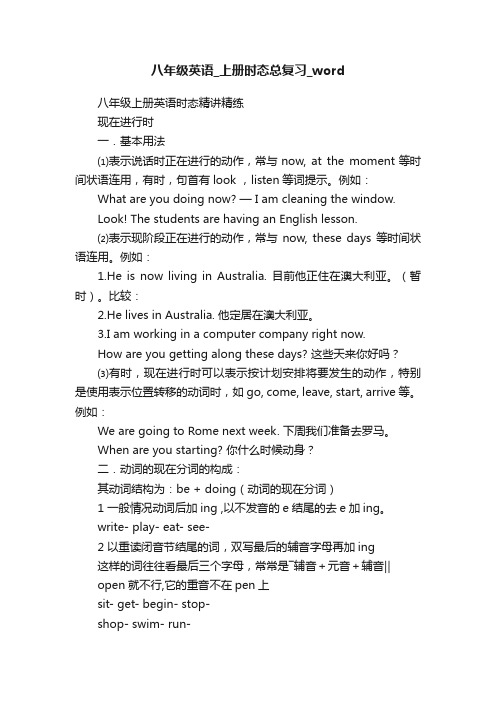
八年级英语_上册时态总复习_word八年级上册英语时态精讲精练现在进行时一.基本用法⑴表示说话时正在进行的动作,常与now, at the moment等时间状语连用,有时,句首有look ,listen等词提示。
例如:What are you doing now? — I am cleaning the window.Look! The students are having an English lesson.⑵表示现阶段正在进行的动作,常与now, these days等时间状语连用。
例如:1.He is now living in Australia. 目前他正住在澳大利亚。
(暂时)。
比较:2.He lives in Australia. 他定居在澳大利亚。
3.I am working in a computer company right now.How are you getting along these days? 这些天来你好吗?⑶有时,现在进行时可以表示按计划安排将要发生的动作,特别是使用表示位置转移的动词时,如go, come, leave, start, arrive等。
例如:We are going to Rome next week. 下周我们准备去罗马。
When are you starting? 你什么时候动身?二.动词的现在分词的构成:其动词结构为:be + doing(动词的现在分词)1 一般情况动词后加ing ,以不发音的e结尾的去e加ing。
write- play- eat- see-2 以重读闭音节结尾的词,双写最后的辅音字母再加ing这样的词往往看最后三个字母,常常是―辅音+元音+辅音‖open就不行,它的重音不在pen上sit- get- begin- stop-shop- swim- run-三.句子结构肯定结构:主语+am/is/are+doing(动词的现在分词)He is watching TV.否定形式:主语+am/is/are+ not+ doing.He is not watching TV.一般疑问句:Be(am/is/are)+主语+doing(动词的现在分词)?Is he watching TV? Are they singing now?特殊疑问句:疑问词+一般疑问结构?What is he doing?现在进行时专项练习一. 用括号中动词的适当形式填空:1. My parents ___ ____(watch)TV now.2 . Look. Three boys ___ ____(run).3. What _______ your mother ___ ____(do)now?4. _______ your dog _______ now?(sleep)5. _______ you _______(listen)to music? Yes, I am.6. Look, Miss Chen ___ ____ football.(play)7. Tom and his sister _______(wait)for you over there.8. Now Class 3 and Class 4_______(have)a test.9. Listen, someone _______(sing)in the classroom.10. ——Where is Zhang Yan?——She _______(talk)with her teacher in the teacher’s office.二. 选择填空:( )1. Who ______ over there now?A. singingB. are singC. is singing( )2. It’s nine ten. The students ______ a music class.A. haveB. havingC. are having( )3. Listen! The boy _______. A. crying B. is crying C. cries ( )4. Don’t talk here. Grandparents ______.A. sleepB. is sleepingC. are sleeping( )5. Is the man _______ tea or milk?A. drinksB. drinkC. drinking三. 按要求进行句型转换:1. Lily is dancing.(改为一般疑问句)________________________________________________2. Kate is looking for her watch.(改为否定句)________________________________________________3. Mrs. White is watching TV.(对划线部分提问)________________________________________________4. I am doing homework.(改为否定句)________________________________________________5. They are waiting for you at the library.(提问)___________________四. 根据中文提示完成句子:1他没在写作业,她在画画。
八年级英语时态总结
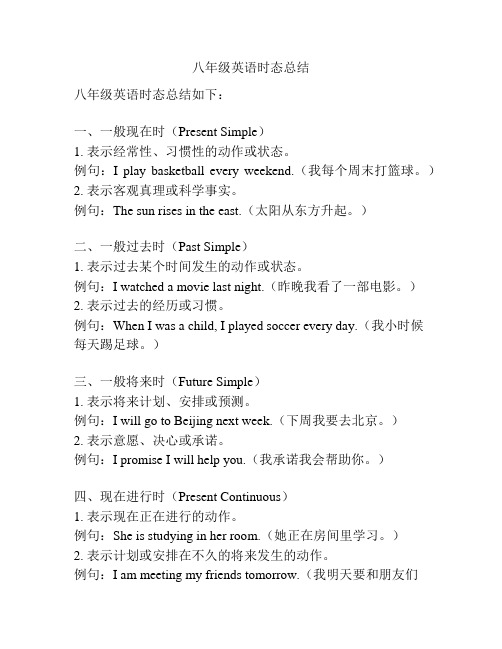
八年级英语时态总结八年级英语时态总结如下:一、一般现在时(Present Simple)1. 表示经常性、习惯性的动作或状态。
例句:I play basketball every weekend.(我每个周末打篮球。
)2. 表示客观真理或科学事实。
例句:The sun rises in the east.(太阳从东方升起。
)二、一般过去时(Past Simple)1. 表示过去某个时间发生的动作或状态。
例句:I watched a movie last night.(昨晚我看了一部电影。
)2. 表示过去的经历或习惯。
例句:When I was a child, I played soccer every day.(我小时候每天踢足球。
)三、一般将来时(Future Simple)1. 表示将来计划、安排或预测。
例句:I will go to Beijing next week.(下周我要去北京。
)2. 表示意愿、决心或承诺。
例句:I promise I will help you.(我承诺我会帮助你。
)四、现在进行时(Present Continuous)1. 表示现在正在进行的动作。
例句:She is studying in her room.(她正在房间里学习。
)2. 表示计划或安排在不久的将来发生的动作。
例句:I am meeting my friends tomorrow.(我明天要和朋友们见面。
)五、过去进行时(Past Continuous)1. 表示过去某一时刻正在进行的动作。
例句:He was reading a book when I entered the room.(我进屋的时候他正在读书。
)2. 表示过去同时发生的两个动作。
例句:I was cooking while he was watching TV.(他在看电视的时候我在做饭。
)六、将来进行时(Future Continuous)表示将来某个时间正在进行的动作。
仁爱版英语八年级上册时态复习专题知识总结讲解及真题训练
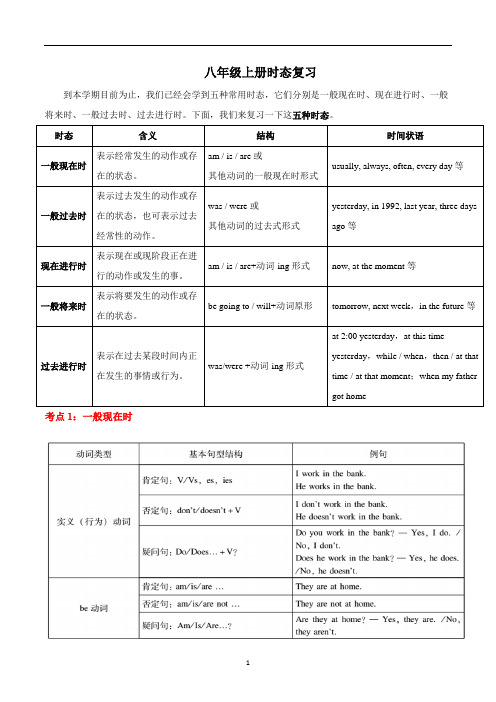
八年级上册时态复习到本学期目前为止,我们已经会学到五种常用时态,它们分别是一般现在时、现在进行时、一般将来时、一般过去时、过去进行时。
下面,我们来复习一下这五种时态。
时态含义结构时间状语一般现在时表示经常发生的动作或存在的状态。
am / is / are或其他动词的一般现在时形式usually, always, often, every day等一般过去时表示过去发生的动作或存在的状态,也可表示过去经常性的动作。
was / were或其他动词的过去式形式yesterday, in 1992, last year, three daysago等现在进行时表示现在或现阶段正在进行的动作或发生的事。
am / is / are+动词-ing形式now, at the moment等一般将来时表示将要发生的动作或存在的状态。
be going to / will+动词原形tomorrow, next week,in the future等过去进行时表示在过去某段时间内正在发生的事情或行为。
was/were +动词-ing形式at 2:00 yesterday,at this timeyesterday,while / when,then / at thattime / at that moment;when my fathergot home考点1:一般现在时1.一般现在时的构成一般现在时主要用动词原形表示,如果主语是第三人称单数,一般在动词原形后加-s或-es。
如:Tom often at home.汤姆在家经常帮助父母做家务。
Sometimes Lucy herself.有时候露西自己洗衣服。
2.与一般现在时连用的时间状语(1)表示频率的副词always,often,usually,sometimes等。
(2)on Sundays,on Monday afternoons,every day,every morning,every year等时间状语。
八年级英语上册时态复习
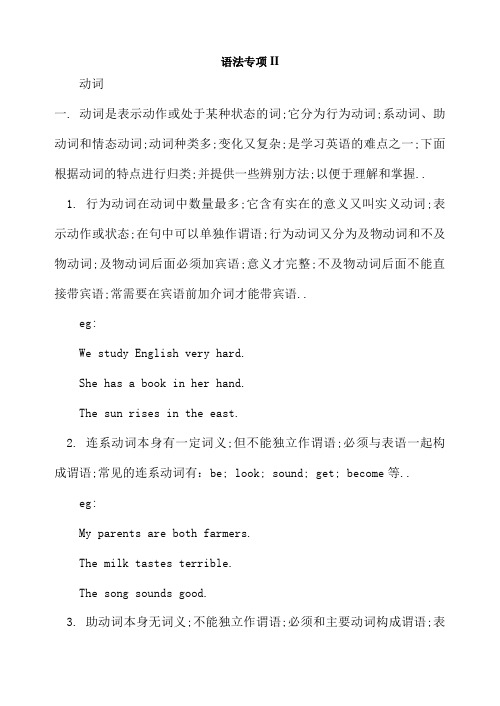
语法专项II动词一. 动词是表示动作或处于某种状态的词;它分为行为动词;系动词、助动词和情态动词;动词种类多;变化又复杂;是学习英语的难点之一;下面根据动词的特点进行归类;并提供一些辨别方法;以便于理解和掌握..1. 行为动词在动词中数量最多;它含有实在的意义又叫实义动词;表示动作或状态;在句中可以单独作谓语;行为动词又分为及物动词和不及物动词;及物动词后面必须加宾语;意义才完整;不及物动词后面不能直接带宾语;常需要在宾语前加介词才能带宾语..eg:We study English very hard.She has a book in her hand.The sun rises in the east.2. 连系动词本身有一定词义;但不能独立作谓语;必须与表语一起构成谓语;常见的连系动词有:be; look; sound; get; become等..eg:My parents are both farmers.The milk tastes terrible.The song sounds good.3. 助动词本身无词义;不能独立作谓语;必须和主要动词构成谓语;表示疑问;否定;时态或其它语法形式..常见的助动词有:be; have; do; will; shall等..eg:Do you have a brotherHave you got an English-Chinese dictionaryI didn’t go to the cinema yesterday.4. 情态动词本身有词义;但不能独立作谓语;只能和主要动词一起构成谓语;表示说话者的语气和情态;情态动词没有人称和数的变化;情态动词本身可以构成疑问和否定;常见的情态动词有:can; may; must; will; shall; need等..eg: Can you sing the English songEveryone must get to school on time.二. 动词的时态:一时态概述:作谓语的动词用来表示动作情况发生时间的各种形式称为时态;英语中的时态;就是通过特殊的动词词尾或加一些相关的助动词be; havehas等;用来表示动作或事件发生的不同时间和方面..eg: He reads newspapers every day.He read the newspaper yesterday.He is going to read the newspaper tomorrow.二一般现在时:1. 动词变化:一般现在时主要用动词原形表示;但第三人称单数后要加词尾-s;另外be和have有特殊的人称形式..在加词尾-s时要注意:读音:2. 一般现在时主要表示:1经常性或习惯性的动作;常与这样的时间状语连用:always; often; usually; sometimes等eg: We always help each other.It often snows in winter.I get up early every morning.2表示主语现在的特征、性格、能力等..eg: He loves sports.Jane is an outgoing girl.Tom and Tim both have medium height.3表示客观、普遍真理eg:Two and four makes six.Water boils at 100℃The moon moves round the earth.3. 一般现在时的疑问句一般以在句首加助动词do;does的方式构成..第三人称单数加does;其他加do;这时动词一概用原形;动词be只需与主语位置对调就行了..eg: Do you like EnglishDo they have story booksWhat does she do every eveningIs she at homeAre you good at English4. 一般现在时的否定式是do notdon’t或does not doesn’t+动词原形来构成的;be动词做谓语动词只需在be后加not构成否定..eg:I don’t like oranges at all.She doesn’t work in the TV station.They aren’t students.I’m not busy every weekend.三. 现在进行时:1. 动词变化:现在进行时由“am /is /are+动词现在分词”构成..加-ing的规则如下:1一般在动词原形末尾加-ing..如:stay-staying do-doinglisten-listening suffer-sufferingwork-working spend-spendinglook-looking2以不发音的字母e结尾的动词;先去掉e;再加-ing..如:make-making take-takinggive-giving ride-ridingplease-pleasing refuse-refusingclose-closing operate-operating3以一个辅音字母结尾的重读闭音节词;先双写这个辅音字母;再加-ing..如:put-putting sit-sittingrun-running win-winningbegin-beginning2. 现在进行时的用法1表示说话时正在进行或发生的动作;这时可以不用时间状语;也可以和now; at present; at the moment等时间状语连用..有时用一个动词;如look看;listen听..eg: What are you reading nowListen Someone is singing in the classroom.2表示当前一段时期的活动或现阶段正在进行的动作..eg: They are working in a factory these days.More and more people are giving up smoking.3表示最近按计划或安排要进行的动作..现在进行时有时可表示一个在最近按计划或安排要进行的动作;即可以用来代替将来时..eg: When are you leavingAre you going to Tibet tomorrow3. 现在进行时的否定句和疑问句比较简单..否定句在beam; is; are后面加not;疑问句把be动词移到主语前..eg:I am not working.What are you reading nowHow are you feeling todayThe train isn’t arriving soon.四. 一般过去时:1. 动词变化:一般过去时主要表示过去的动作或状态;在句中由主语+动词的过去式来表达..2. 一般过去时的基本用法:1带有确定的过去时间状语时;要用过去时..eg: yesterday; last year; just now; two days ago; in the old days等eg: He left just now.Lei Feng was a good soldier.What did you have for breakfast this morning2表示过去某一段时间内经常或反复发生的动作;这时常和表示频度的状语连用..eg: Last term we often did experiments.He always went to work by bus.五. be going to 表示一般将来1. 用法:表示现在打算在最近或将来要做的事;或表示说话人根据已有的迹象认为很有可能要发生的事情;be随着人称的变化变成am; is; areeg: We are going to have a new subject this year.It’s going to rain this afternoon.I’m going to be a pilot when I grow up.2. be going to 的否定句在be动词后加上not;be going to 的疑问句把be动词移到主语前..eg:He isn’t going to see his brother tomorrow.I’m not going to tell you about it.Who’s going to use itIs your sister going to bring your lunchWhat are you going to do next Sunday.模拟试题答题时间:70分钟一. 改错:例1:The rose dark red. →The rose is dark red.1. He very likes swimming.2. He can helps you.3. We haven’t a good time.4. What are you do after school every day5. Sometimes I listen music. sometimes I play outside.6. The fish smells not good.7. We should buy some chicken. There are little left.8. There have many birds in the sky.9. My mother’s glasses is broken.10. A pair of shoes are nearly one thousand.11. What colour are her hair12. Does he his homework13. A: Do you like your classB: Yes. I like.14. He always do his shopping on Friday evening.15. I very sorry I forgot your birthday.16. I have no brother and sister.二. 连词组句:1. listen; morning; the; to; I; radio; the; in; often2. of; men; nurses; good; sick; hospital; care; in; take; the3. weekdays; he; the; goes; cinema; never; during; the; to4. computer; got; new; you; a; have5. weekends; he; rest; does; a; got; have; on6. good; Li Ming; do; and; often; I deeds7. museum; they; the; often; science; visit; how; do8. the; in; any; there; kitchen; food; is9. homework; does; day; when; Tom; his; every; where; and; do10. a; there; vegetables; many; but; apples; aren’t; lot; there; of; are; there三. 用括号里的动词的适当形式填空:1. There be______some glasses on it.2. He go______to the park every day.3. My uncle live______ in Nanjing now.4. ______ Lucy and Lily like______China5. Li Leinot like______ to drink orange soda.6. The girl go______ home at 4:30 in the afternoon.7. ______ Kate speak______ French Yes; she does.8. Jim not ride______his bike often.9. If he be______ free tomorrow; he go______ with us.10. As soon as they get______ there next month; he call______me.11. ______Li Ming’s father have______ his lunch at home12. Tom not do______the morning exercises often.13. I be______ hungry and my sister be______ thirsty.14. The baby have______ curly hair.15. Everybody have______ a chance to win.16. I clean______ my room once a week.17. Nobodytell______ them anything.18. There be______ a lot of chicken on the plate.19. Mr. Li teach______ the second grade.20. The boy watch______ TV every evening.21. Mary play______the violin quite well.22. David study______Chinese and I study______ English.23. The game be______ interesting.24. Many children be______ on the playground.25. He have_______ a good time at your party.26. I have______ a new bicycle.四. 用所给词的适当形式填空:1. Tom and his father ______swimnow.2. Look They ______runalong the street.3. We ______practicehard these days because we will have a big match next month.4. What ______he ______do at nine o’clock last night5. They ______listento the music at that time.6. When the headmaster came in; the students______readthe text.7. We ______watchTV when suddenly the telephone rang.8. She ______makethe paper flowers the whole night.9. A: _______ you ______studyingEnglishB: Yes; I am.10. Let’s go out. It ______not rainnow.11. Hurry up Everybody ______waitfor you.12. A: ______you / listento the radioB: No; You can turn it off.13. I ______watchTV at seven o’clock yesterday evening.14. A: What ______you / lookforB: I ______lookfor my wallet. There is something important in it.15. Look. It ______rainhard. We’ll get wet if we go out.五. 选词填空:一选词填空:1. I ______am; is; was; werebusy last week.2. Tom and I ______am; are; was; werelate for school yesterday.3. I ______walk; walks; walked; walkingto school the other day.4. Rose ______does not; didn’t; has been; has tovisit her uncle the month before lastmonth5. There ______is; was; are; werea lot of people in this village ten years ago.6. Mother ______am; is; was; wereill in bed last night.7. It ______rain; rains; rained; raininga lot last year.二用括号中动词的适当形式填空:1. My uncle in London ______senda birthday present to me yesterday.2. When ______beyou born3. As soon as he arrived in the country; he ______phoneme.4. When I ______knockat his door; he was cooking.5. We were watching TV when the light ______goout.6. He said he ______not likemaths at all.三用括当的词完成下列句子..1. ______you make this cake last night Yes. I did. I _______it for you.2. Did Tom _______ home at five yesterdayNo; he _______. He came home at six.3. What _______ you _______ at the store I bought a camera.4. Were you at home yesterday Yes; I _______.5. Where did you catch the fish I _______ it in the river near my house.六. 完成下列句子:1. 你长大了想当什么我打算当个电脑程序员..What _____ you ______ ______ _______ when you ______ _______ I’m ______ to _______ a _______ _______.2. 你哥哥长大了打算当什么他打算当个专业的篮球运动员..What _____ your brother _____ _________ ______ when he _____________He’s _____ to ______ a _______ _________ player.3. 你打算怎么做我打算学计算机学.._____ are you ______ ________ ________ thatI’m _____ _______ _______ computer _______.4. 你哥哥打算怎么做他打算每天练篮球.._____ is your brother _____ _____ _____He’s _____ ______ _________ basketball every day.5. 她打算下学期上一些表演课吗是的..______ she ______ _______ _________ some ______ lessons Yes; she ________.试题答案1. He likes swimming.2. He can help you.3. We don’t have a good time.4. What do you do after school every day5. Sometimes I listen to music; sometimes I play outside.6. The fish doesn’t smell good.7. We should buy some chicken. There is little left.8. There are many birds in the sky.9. My mother’s glasses are broken.10. A pair of shoes is nearly one thousand.11. If he doesn’t feel well he will go to visit the History Museum.12. What colour is her hair13. Does he do his homework14. A: Do you like your classB: Yes. I do.15. He always does his shopping on Friday evening.16. I am sorry I forgot your birthday.二.1. I often listen to the radio in the morning.2. Nurses take good care of sick men in the hospital.3. He never goes to the cinema during the weekdays.4. Have you got a new computer5. Does he have a rest on weekends6. Li Ming and I often do good deeds.7. How often do you visit the science museum8. Is there any food in the kitchen9. When and where does Tom do his homework every day10. There are a lot of vegetables but there aren’t many applesthere.Or: There are a l ot of apples but there aren’t many vegetables there.三. 1. are 2. goes 3. lives 4. Do; like 5. doesn’t like6. goes7. Does; speak8. doesn’t ride9. is; will go 10. get; will call 11. Does; have12. doesn’t do13. am; is 14. has15. has 16. clean 17. tells 18. is19. teaches 20. watches 21. plays 22. studies; study23. is 24. are 25. has 26. have四. 1. are swimming 2. are running 3. are practicing4. was; doing5. were listening6. were reading7. were watching 8. was making 9. Are; studying10. isn’t raining11. is waiting 12. Are you listening13. was watching 14. are you looking; am looking15. is raining五.一1. was 2. were 3. walked 4. did not 5. were 6. was7. rained二1. sent 2. were 3. phoned 4. knocked 5. went 6. didn’t like三1. Did; made 2. come; didn’t3. did; buy4. was5. caught六.1. are; going; to; be; grow; up; going; be; computer; programmer2. is; going; to; be; grows; up; going; be; professional; basketball.3. How; going; to; do; going; to; study; science4. How; going; to; do; that; going; to; play5. Is; going; to; take; acting; is。
人教版八年级英语上册常用的时态复习(35张)
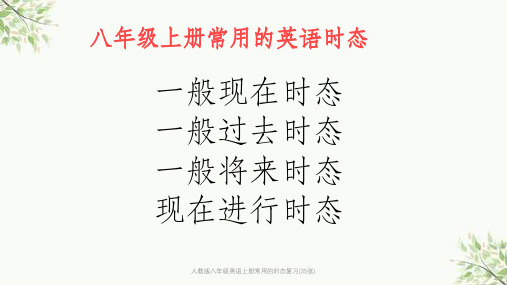
• The train leaves at 17:40.
会议在七点钟开始。
火车17:40离开。
人教版八年级英语上册常用的时态复习(35张)
一般现在时态的几点注意:
• 3)书报的标题、小说、戏剧、图片等情节介绍常用 一般现在时。例如:
• China Declares Manned Spaceflight Successful.
弗朗西斯穿过去,把球传给姚明,姚明跳起来,接住球投进篮里。
人教版八年级英语上册常用的时态复习(35张)
一般现在时态的几点注意:
• 4) 在由if, unless, even if ,so long as , as long as 等引导的 条件状语从句和在由when, before, after, until, till, as soon as, by the time, each time, the moment, immediately等引导的时间状语从句中,常用一般现在时表示 将来时间。例如:
• Please let me know immediately you get the results. 你一得到 结果,就请马上告诉我。
人教版八年级英语上册常用的时态复习(35张)
一般现在时态的几点注意:
• 5),还要注意其动词形式的变化。该时态主要由动词 原形表示,但第三人称单数后要加词尾-s或 -es,be 和have有特殊的变化形式, be (am, is , are) have( has ) 。例表如下:
人教版八年级英语上册常用的时态复习(35张)
一般现在时的几种主要用法
• 1)一般现在时表示客观事实、客观存在的普遍真理、 用于一般现在时的时间状语常见的有:often, usually,always,sometimes, seldom,ever, never,every day(week,month,year), once a year,now and them,from time to time。例如:
八年级上册英语知识点总结归纳

八年级上册英语知识点总结归纳一、基本语法知识1. 时态:一般现在时、一般过去时、现在进行时、过去进行时、一般将来时、过去将来时等。
2. 动词的用法:及物动词和不及物动词的区别,动词的时态和人称变化。
3. 名词的用法:可数名词和不可数名词的区别,名词的复数形式。
4. 形容词和副词的用法:形容词和副词的比较级和最高级形式。
5. 代词的用法:人称代词、物主代词、指示代词等。
6. 介词的用法:介词短语的构成和用法。
7. 定冠词和不定冠词的用法:a, an, the的区别和用法。
二、词汇知识1. 常见的动词、名词、形容词和副词的用法。
2. 数词:基数词和序数词的用法。
3. 介词短语中常见的介词和短语的用法。
4. 连词:and, but, or等的用法。
5. 感叹词:how, what等的用法。
三、句型知识1. 肯定句、否定句和疑问句的基本用法。
2. There be 句型的用法。
3. 情态动词的用法:can, could, may, might, must等。
4. 复合句的构成和用法。
5. 定语从句的引导词和用法。
四、交际用语1. 问候和介绍自己。
2. 提出请求和建议。
3. 表示喜欢和不喜欢。
4. 打电话和约会。
五、阅读技巧1. 掌握不同类型文章的阅读技巧,如记叙文、说明文、议论文等。
2. 学会根据上下文推测词义。
3. 注意文章中的重点句子和关键信息。
六、写作技巧1. 学会使用适当的时态和语法结构。
2. 注意语言表达的准确性。
3. 练习写日记、信件、短文等不同类型的作文。
人教版八年级英语上册常用的时态复习(35张)
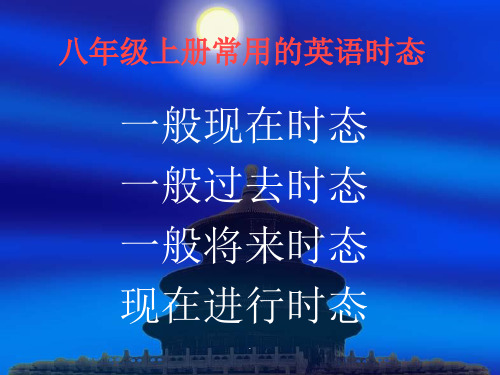
He often came to see me when I was in hospital.在我住院期间,他经常来看我。
.
二、一般过去时
谓语动词变过去式的规则: 动词情况构成方式例词一般情况加-ed : play—played, work—worked,look—looked 以 -e 结尾的动词加-d :live—lived,hope—hoped,
.
二、一般过去时
一般过去时态的否定和疑问: 1)谓语是实义动词时,要借助于助动词did We didn’t see anything wonderful yesterday . Did they finish their homework last Sunday ? She didn’t do any work this morning . When did he come to your school ? 2)谓语中有be或情态助动词时,不再另加其它助动
俩明年中学毕业。
.
三、一般将来时2) be going to +不 定式,表示将来。
a. 表示经过事先考虑与打算、按计划或安排将要发生的动作。 例如:
I ' m going to finish the report this afternoon.今天下午我将 会写完这份报告。
——What are you going to do when you grow up?长大以 后你打算干什么?
弗朗西斯穿过去,把球传给姚明,姚明跳起来,接住球投进篮里。
.
一般现在时态的几点注意:
4) 在由if, unless, even if ,so long as , as long as 等引导 的条件状语从句和在由when, before, after, until, till, as soon as, by the time, each time, the moment, immediately等引导的时间状语从句中,常用一般现在时表 示将来时间。例如:
人教版英语八年级上册时态复习(含口诀)

标志词
此时此刻现阶段, 看听在哪请安静
now look ! listen! at this moment these days
现在进行时
结构
am/is/are +现在分词(v-ing)
,
• 进行时表进来的词: come,arrive,go,move,fly,start,leave,die,
• meet,return,stay等。 • 来来去去飞,开始离开死
实战演练
1.Look! Some children ___________ (play) football on the playground.
(二)否定句:主语 + did not (didn’t) + 动词原形 例: The monkey didn’t give a banana to him.
(三)一般疑问句: Did +主语 + 动词原形+ 其他? 例: Did the monkey give a banana to him? — Yes, it did. /No, it didn’t.
3. If it __________ (not rain) tomorrow, we’ll go to the zoo.
4. Don’t get off the bus until it__ (stop).
5. The teacher told us that the earth
_________(travel) round the sun.
ago ,in 1990
last ,in 1990
八年级4个时态知识点总结归纳
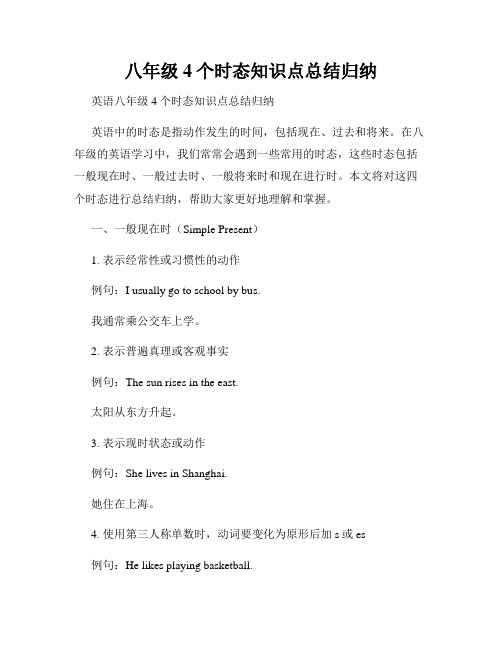
八年级4个时态知识点总结归纳英语八年级4个时态知识点总结归纳英语中的时态是指动作发生的时间,包括现在、过去和将来。
在八年级的英语学习中,我们常常会遇到一些常用的时态,这些时态包括一般现在时、一般过去时、一般将来时和现在进行时。
本文将对这四个时态进行总结归纳,帮助大家更好地理解和掌握。
一、一般现在时(Simple Present)1. 表示经常性或习惯性的动作例句:I usually go to school by bus.我通常乘公交车上学。
2. 表示普遍真理或客观事实例句:The sun rises in the east.太阳从东方升起。
3. 表示现时状态或动作例句:She lives in Shanghai.她住在上海。
4. 使用第三人称单数时,动词要变化为原形后加s或es例句:He likes playing basketball.他喜欢打篮球。
二、一般过去时(Simple Past)1. 表示过去某个时间发生的动作或存在的状态例句:We watched a movie last night.昨晚我们看了一部电影。
2. 某些动词的过去式需要转换例句:I ran to catch the bus.我跑着赶上了公交车。
3. 句中使用时间标志词,如yesterday、last week等例句:She visited her grandparents last month.她上个月去看望了她的祖父母。
三、一般将来时(Simple Future)1. 表示将来要发生的动作或存在的状态例句:I will help you with your homework.我会帮你做作业。
2. 表示打算、计划或意图例句:They are going to have a party next week.他们下周要开一个派对。
3. 表示预测或揣测例句:It will rain tomorrow.明天会下雨。
四、现在进行时(Present Continuous)1. 表示现在正在进行的动作例句:She is studying for the exam.她正在为考试而学习。
八年级英语上册期末复习时态
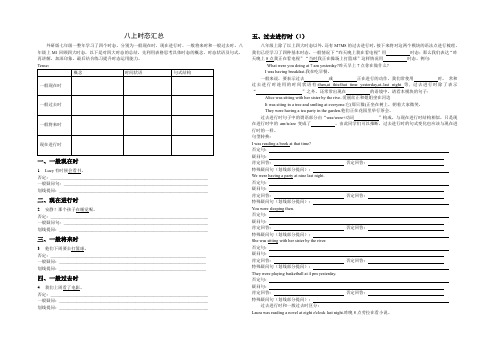
八上时态汇总外研版七年级一整年学习了四个时态,分别为一般现在时、现在进行时、一般将来时和一般过去时。
八年级上M1回顾四大时态,以下是对四大时态的总结。
先利用表格思考具体时态的概念、时态状语及句式。
再讲解,加深印象。
最后结合练习提升时态运用能力。
一、一般现在时1.Lucy有时候会看书。
否定:________________________________________________________________________一般疑问句:__________________________________________________________________划线提问:____________________________________________________________________二、现在进行时2.安静!那个孩子在睡觉呢。
否定:________________________________________________________________________一般疑问句:__________________________________________________________________划线提问:____________________________________________________________________三、一般将来时3.他们下周要去打篮球。
否定:_______________________________________________________________________一般疑问:___________________________________________________________________划线提问:___________________________________________________________________四、一般过去时4.我们上周看了电影。
人教版初中英语八年级上册时态归纳和作文

一、八年级上册涉及的时态1、一般过去时(Simple Past Tense)概念:过去某个时间或某段时间发生的动作或存在的状态;过去经常或反复发生的动作。
结构:谓语动词用过去式动词变过去式的规则:①一般情况,加-ed②以e结尾的动词,加-d③以重读闭音节结尾的动词,末尾只有一个辅音字母(辅元辅,除er),双写辅音字母,再加-ed④以辅音字母加y结尾的动词,变y为i,再加-ed⑤不规则动词表见八上P142时间状语:yesterday昨天,last night/week/year/month昨晚/上周/去年/上个月,in1990在1990年,two days ago两天前,3years ago三年前。
涉及单元:Unit12、一般现在时(Simple Present Tense)概念:经常、习惯性的动作或存在的状态。
结构:当主语为第一、二人称或三人称复数时,谓语动词用原形;当主语为第三人称单数时,谓语动词用第三人称单数形式。
动词变第三人称单数形式的规则:①一般情况,加-s②以s,x,ch,sh结尾的动词,加es③以辅音字母加y结尾的动词,变y为i,再加-es时间状语:every day/morning/weekend/每天/每早/每周,on the weekends/在周末,in the morning在上午,in the afternoon在下午,on Sundays在周日。
涉及单元:Unit2,3,4,53、一般将来时(Simple Future Tense)概念:将来某个时间要发生的动作或存在的状态;将来经常或反复发生的动作。
结构:be going to+v.原;will/shall+v.原There will be;there is/are going to be时间状语:tomorrow明天,next week/month/year下周/下个月/明年,in+一段时间in100years100年后,in25years25年后。
(完整版word)八年级上英语动词的时态复习总结含答案解析
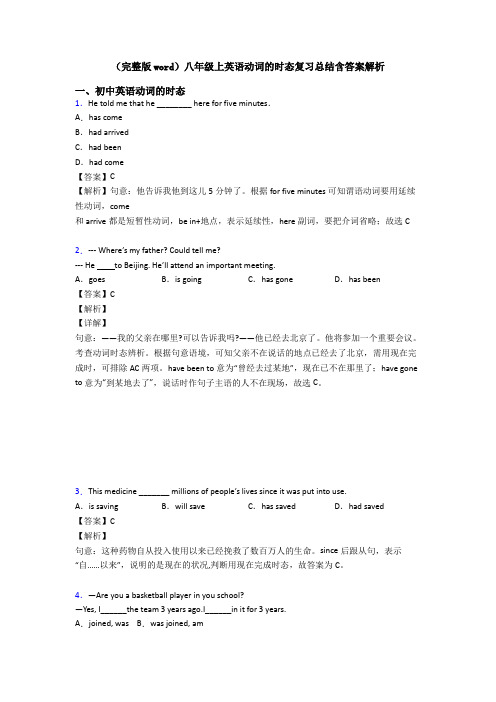
(完整版word)八年级上英语动词的时态复习总结含答案解析一、初中英语动词的时态1.He told me that he ________ here for five minutes.A.has comeB.had arrivedC.had beenD.had come【答案】C【解析】句意:他告诉我他到这儿5分钟了。
根据for five minutes可知谓语动词要用延续性动词,come和 arrive都是短暂性动词,be in+地点,表示延续性,here副词,要把介词省略;故选C2.--- Where’s my father? Could tell me?--- He to Beijing. He’ll attend an important meeting.A.goes B.is going C.has gone D.has been【答案】C【解析】【详解】句意:——我的父亲在哪里?可以告诉我吗?——他已经去北京了。
他将参加一个重要会议。
考查动词时态辨析。
根据句意语境,可知父亲不在说话的地点已经去了北京,需用现在完成时,可排除AC两项。
have been to意为“曾经去过某地”,现在已不在那里了;have gone to意为“到某地去了”,说话时作句子主语的人不在现场,故选C。
3.This medicine _______ millions of people’s lives since it was put into use.A.is saving B.will save C.has saved D.had saved【答案】C【解析】句意:这种药物自从投入使用以来已经挽救了数百万人的生命。
since后跟从句,表示“自……以来”,说明的是现在的状况,判断用现在完成时态,故答案为C。
4.—Are you a basketball player in you school?—Yes, I______the team 3 years ago.I______in it for 3 years.A.joined, was B.was joined, amC.have joined,have been D.joined, have been【答案】D【解析】【分析】句意:——你在你们学校是一名篮球运动员吗?——是的,我在3年前加入了篮球队。
- 1、下载文档前请自行甄别文档内容的完整性,平台不提供额外的编辑、内容补充、找答案等附加服务。
- 2、"仅部分预览"的文档,不可在线预览部分如存在完整性等问题,可反馈申请退款(可完整预览的文档不适用该条件!)。
- 3、如文档侵犯您的权益,请联系客服反馈,我们会尽快为您处理(人工客服工作时间:9:00-18:30)。
语法专项II动词一. 动词是表示动作或处于某种状态的词,它分为行为动词,系动词、助动词和情态动词,动词种类多,变化又复杂,是学习英语的难点之一,下面根据动词的特点进行归类,并提供一些辨别方法,以便于理解和掌握。
1. 行为动词在动词中数量最多,它含有实在的意义(又叫实义动词),表示动作或状态,在句中可以单独作谓语,行为动词又分为及物动词和不及物动词,及物动词后面必须加宾语,意义才完整,不及物动词后面不能直接带宾语,常需要在宾语前加介词才能带宾语。
eg:We study English very hard.She has a book in her hand.The sun rises in the east.2. 连系动词本身有一定词义,但不能独立作谓语,必须与表语一起构成谓语,常见的连系动词有:be, look, sound, get, become等。
eg:My parents are both farmers.The milk tastes terrible.The song sounds good.3. 助动词本身无词义,不能独立作谓语,必须和主要动词构成谓语,表示疑问,否定,时态或其它语法形式。
常见的助动词有:be, have, do, will, shall等。
eg:Do you have a brother?Have you got an English-Chinese dictionary?I didn’t go to the cinema yesterday.4. 情态动词本身有词义,但不能独立作谓语,只能和主要动词一起构成谓语,表示说话者的语气和情态,情态动词没有人称和数的变化,情态动词本身可以构成疑问和否定,常见的情态动词有:can, may, must, will, shall, need等。
eg: Can you sing the English song?Everyone must get to school on time.二. 动词的时态:(一)时态概述:作谓语的动词用来表示动作(情况)发生时间的各种形式称为时态,英语中的时态,就是通过特殊的动词词尾或加一些相关的助动词be, have(has)等,用来表示动作或事件发生的不同时间和方面。
eg: He reads newspapers every day.He read the newspaper yesterday.He is going to read the newspaper tomorrow.(二)一般现在时:1. 动词变化:一般现在时主要用动词原形表示,但第三人称单数后要加词尾-s,另外be 和have有特殊的人称形式。
2. 一般现在时主要表示:(1)经常性或习惯性的动作,常与这样的时间状语连用:always, often, usually, sometimes等eg: We always help each other.It often snows in winter.I get up early every morning.(2)表示主语现在的特征、性格、能力等。
eg: He loves sports.Jane is an outgoing girl.Tom and Tim both have medium height.(3)表示客观、普遍真理eg:Two and four makes six.Water boils at 100℃The moon moves round the earth.3. 一般现在时的疑问句一般以在句首加助动词do,does的方式构成。
第三人称单数加does,其他加do,这时动词一概用原形;动词be只需与主语位置对调就行了。
eg: Do you like English?Do they have story books?What does she do every evening?Is she at home?Are you good at English?4. 一般现在时的否定式是do not(don’t)或does not (doesn’t)+动词原形来构成的,be动词做谓语动词只需在be后加not构成否定。
eg:I don’t like oranges at all.She doesn’t work in the TV station.They aren’t students.I’m not busy every weekend.三. 现在进行时:1. 动词变化:现在进行时由“am /is /are+动词现在分词”构成。
加-ing的规则如下:(1)一般在动词原形末尾加-ing。
如:stay-staying do-doinglisten-listening suffer-sufferingwork-working spend-spendinglook-looking(2)以不发音的字母e结尾的动词,先去掉e,再加-ing。
如:make-making take-takinggive-giving ride-ridingplease-pleasing refuse-refusingclose-closing operate-operating(3)以一个辅音字母结尾的重读闭音节词,先双写这个辅音字母,再加-ing。
如:put-putting sit-sittingrun-running win-winningbegin-beginning2. 现在进行时的用法(1)表示说话时正在进行或发生的动作,这时可以不用时间状语,也可以和now, at present, at the moment等时间状语连用。
有时用一个动词,如look(看),listen(听)。
eg: What are you reading now?Listen! Someone is singing in the classroom.(2)表示当前一段时期的活动或现阶段正在进行的动作。
eg: They are working in a factory these days.More and more people are giving up smoking.(3)表示最近按计划或安排要进行的动作。
现在进行时有时可表示一个在最近按计划或安排要进行的动作,即可以用来代替将来时。
eg: When are you leaving?Are you going to Tibet tomorrow?3. 现在进行时的否定句和疑问句比较简单。
否定句在be(am, is, are)后面加not;疑问句把be动词移到主语前。
eg:I am not working.What are you reading now?How are you feeling today?The train isn’t arriving soon.四. 一般过去时:1. 动词变化:一般过去时主要表示过去的动作或状态,在句中由主语+动词的过去式来2. 一般过去时的基本用法:(1)带有确定的过去时间状语时,要用过去时。
(eg: yesterday, last year, just now, two days ago, in the old days等)eg: He left just now.Lei Feng was a good soldier.What did you have for breakfast this morning?(2)表示过去某一段时间内经常或反复发生的动作,这时常和表示频度的状语连用。
eg: Last term we often did experiments.He always went to work by bus.五. be going to 表示一般将来1. 用法:表示现在打算在最近或将来要做的事,或表示说话人根据已有的迹象认为很有可能要发生的事情,be随着人称的变化变成(am, is, are)eg: We are going to have a new subject this year.It’s going to rain this afternoon.I’m going to be a pilot when I grow up.2. be going to 的否定句在be动词后加上not;be going to 的疑问句把be动词移到主语前。
eg:He isn’t going to see his brother tomorrow.I’m not going to tell you about it.Who’s going to use it?Is your sister going to bring your lunch?What are you going to do next Sunday.【模拟试题】(答题时间:70分钟)一. 改错:例1:The rose dark red. →The rose is dark red.1. He very likes swimming.2. He can helps you.3. We haven’t a good time.4. What are you do after school every day?5. Sometimes I listen music. sometimes I play outside.6. The fish smells not good.7. We should buy some chicken. There are little left.8. There have many birds in the sky.9. My mother’s glasses is broken.10. A pair of shoes are nearly one thousand.11. What colour are her hair?12. Does he his homework?13. A: Do you like your class?B: Yes. I like.14. He always do his shopping on Friday evening.15. I very sorry I forgot your birthday.16. I have no brother and sister.二. 连词组句:1. listen, morning, the, to, I, radio, the, in, often2. of, men, nurses, good, sick, hospital, care, in, take, the3. weekdays, he, the, goes, cinema, never, during, the, to4. computer, got, new, you, a, have?5. weekends, he, rest, does, a, got, have, on?6. good, Li Ming, do, and, often, I deeds7. museum, they, the, often, science, visit, how, do?8. the, in, any, there, kitchen, food, is?9. homework, does, day, when, Tom, his, every, where, and, do?10. a, there, vegetables, many, but, apples, aren’t, lot, there, of, are, there三. 用括号里的动词的适当形式填空:1. There (be)______some glasses on it.2. He (go)______to the park every day.3. My uncle (live)______ in Nanjing now.4. ______ Lucy and Lily (like)______China?5. Li Lei(not like)______ to drink orange soda.6. The girl (go)______ home at 4:30 in the afternoon.7. ______ Kate (speak)______ French? Yes, she does.8. Jim (not ride)______his bike often.9. If he (be)______ free tomorrow, he (go)______ with us.10. As soon as they (get)______ there next month, he (call)______me.11. ______Li Ming’s father (have)______ his lunch at home?12. Tom (not do)______the morning exercises often.13. I (be)______ hungry and my sister (be)______ thirsty.14. The baby (have)______ curly hair.15. Everybody (have)______ a chance to win.16. I (clean)______ my room once a week.17. Nobody(tell)______ them anything.18. There (be)______ a lot of chicken on the plate.19. Mr. Li (teach)______ the second grade.20. The boy (watch)______ TV every evening.21. Mary (play)______the violin quite well.22. David (study)______Chinese and I (study)______ English.23. The game (be)______ interesting.24. Many children (be)______ on the playground.25. He (have)_______ a good time at your party.26. I (have)______ a new bicycle.四. 用所给词的适当形式填空:1. Tom and his father ______(swim)now.2. Look! They ______(run)along the street.3. We ______(practice)hard these days because we will have a big match next month.4. What ______he ______(do)at nine o’clock last night?5. They ______(listen)to the music at that time.6. When the headmaster came in, the students______(read)the text.7. We ______(watch)TV when suddenly the telephone rang.8. She ______(make)the paper flowers the whole night.9. A: _______ you ______(studying)English?B: Yes, I am.10. Let’s go out. It ______(not rain)now.11. Hurry up! Everybody ______(wait)for you.12. A: ______(you / listen)to the radio?B: No, You can turn it off.13. I ______(watch)TV at seven o’clock yesterday evening.14. A: What ______(you / look)for?B: I ______(look)for my wallet. There is something important in it.15. Look. It ______(rain)hard. We’ll get wet if we go out.五. 选词填空:(一)选词填空:1. I ______(am, is, was, were)busy last week.2. Tom and I ______(am, are, was, were)late for school yesterday.3. I ______(walk, walks, walked, walking)to school the other day.4. Rose ______(does not, didn’t, has been, has to)visit her uncle the month before last (month)5. There ______(is, was, are, were)a lot of people in this village ten years ago.6. Mother ______(am, is, was, were)ill in bed last night.7. It ______(rain, rains, rained, raining)a lot last year.(二)用括号中动词的适当形式填空:1. My uncle in London ______(send)a birthday present to me yesterday.2. When ______(be)you born?3. As soon as he arrived in the country, he ______(phone)me.4. When I ______(knock)at his door, he was cooking.5. We were watching TV when the light ______(go)out.6. He said he ______(not like)maths at all.(三)用括当的词完成下列句子。
